15 Words you never knew came from literature!


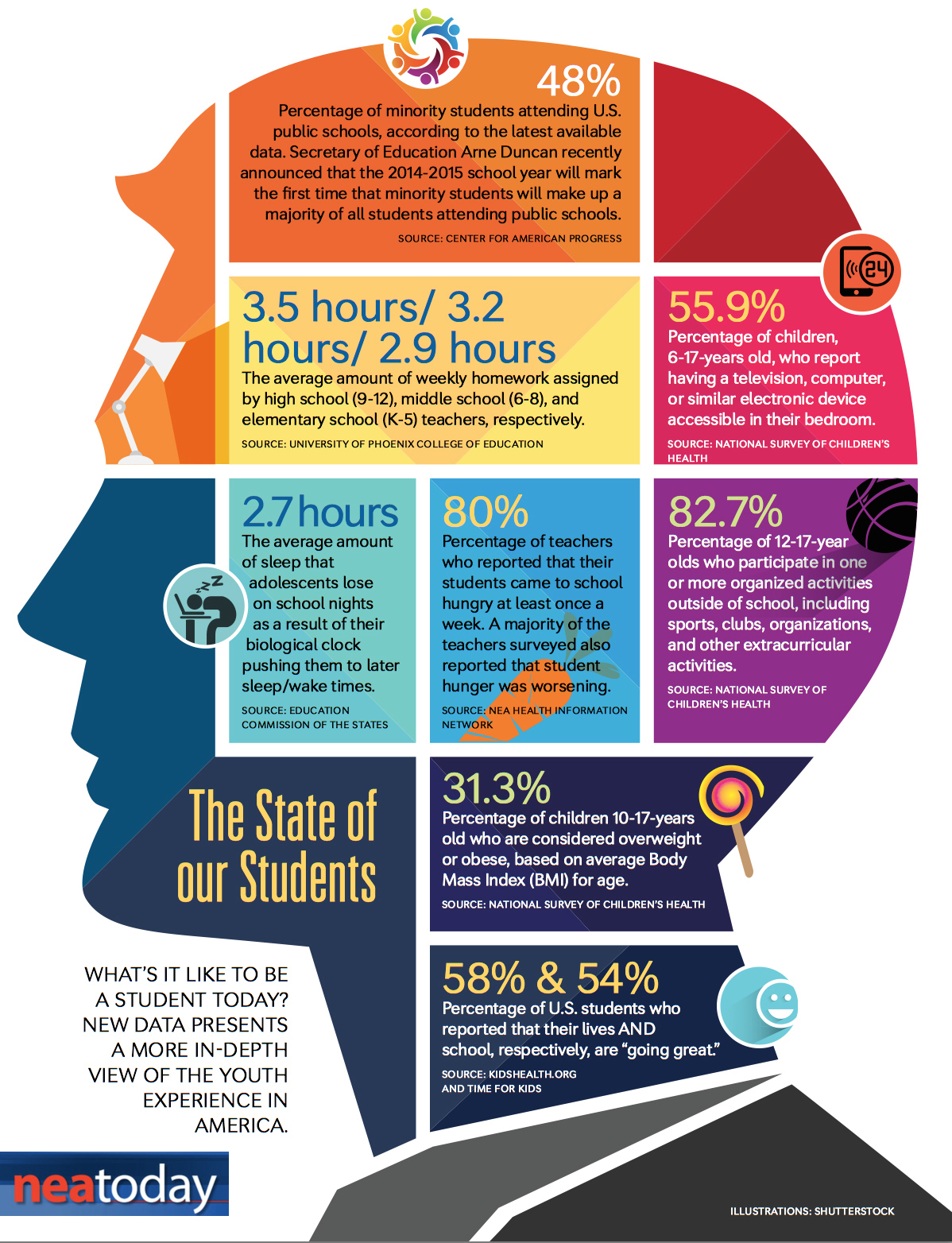


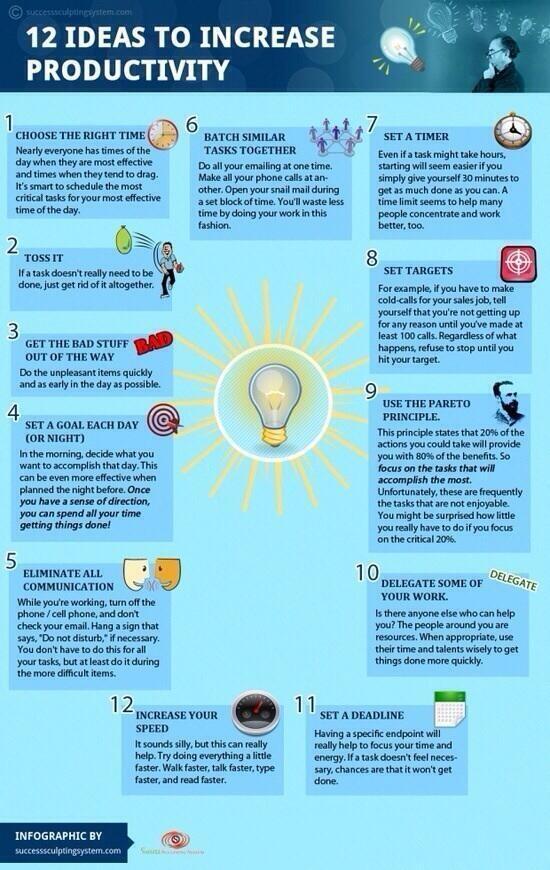
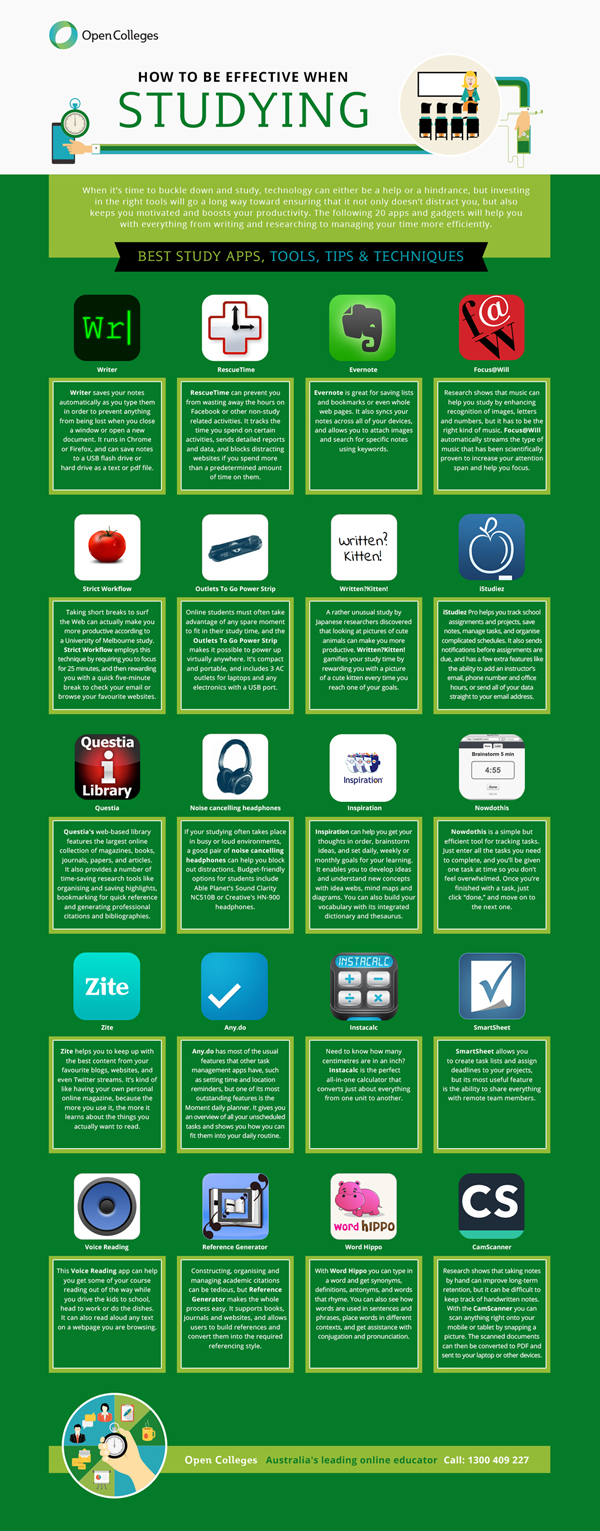
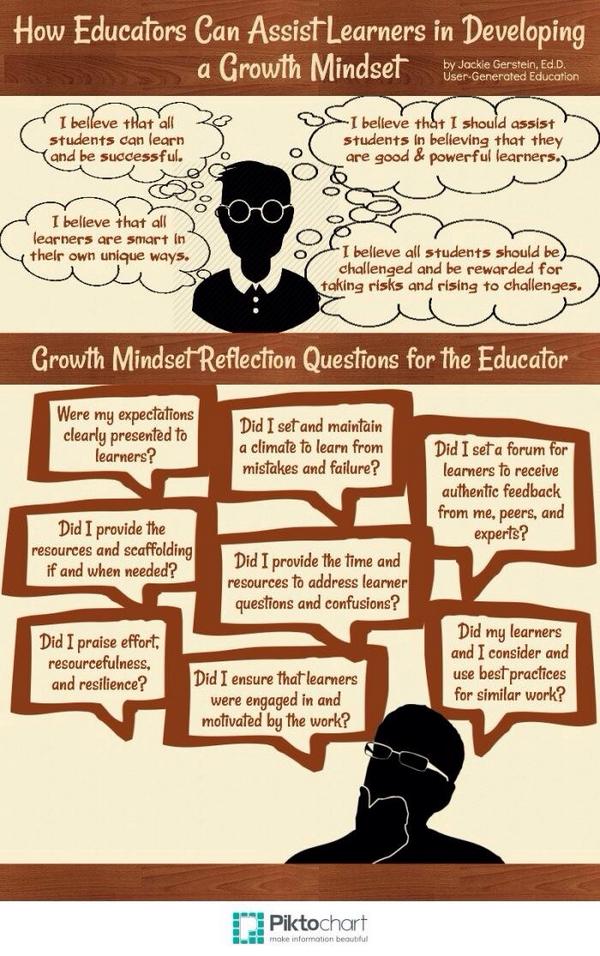


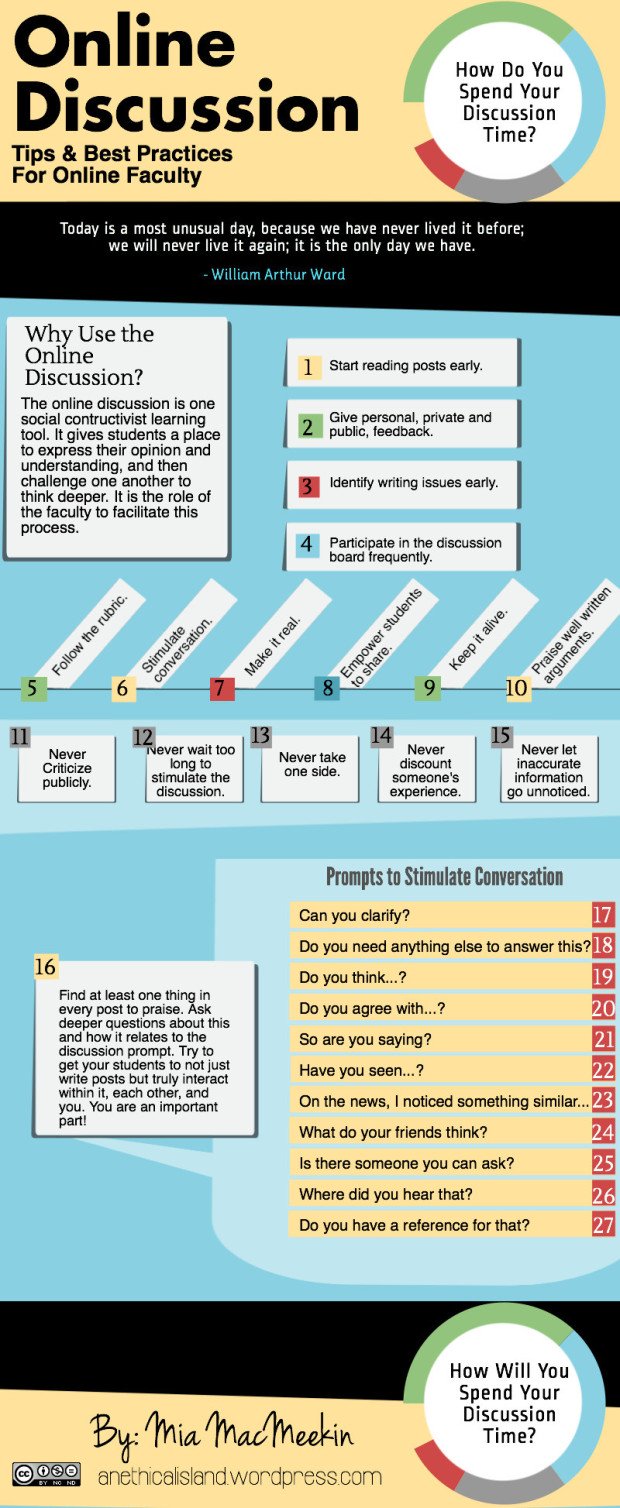

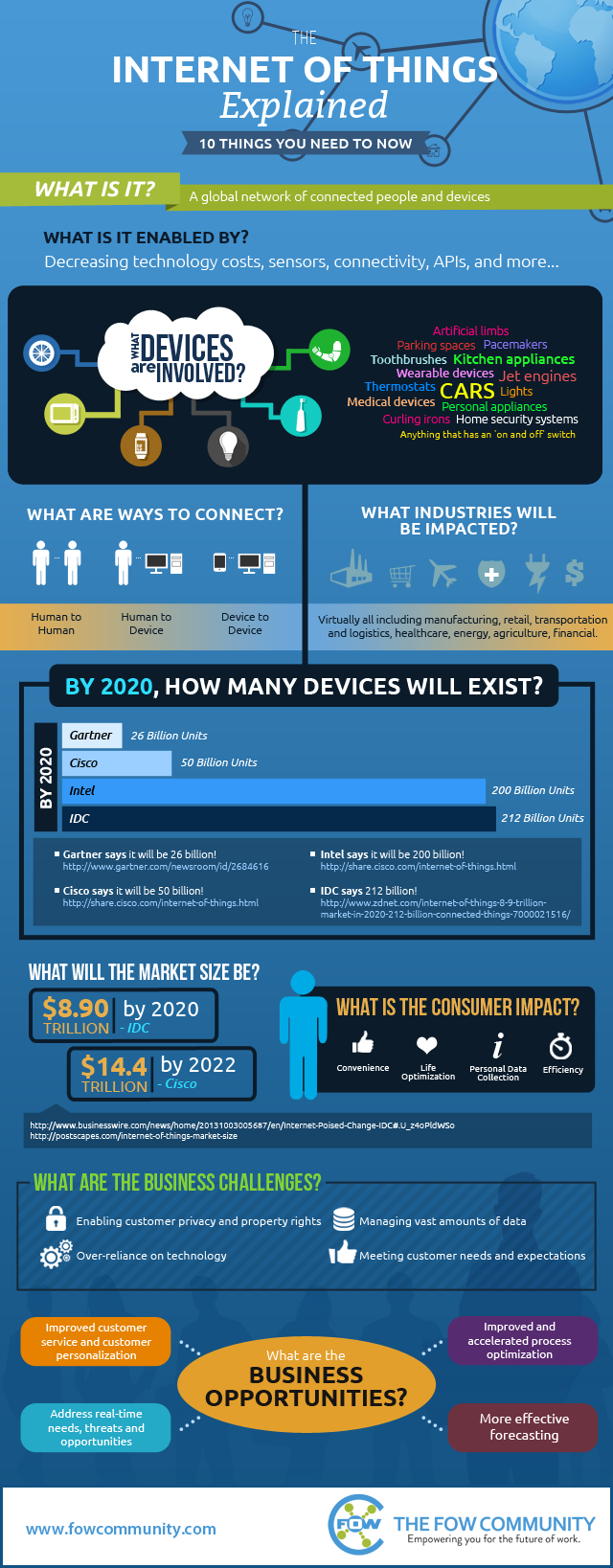


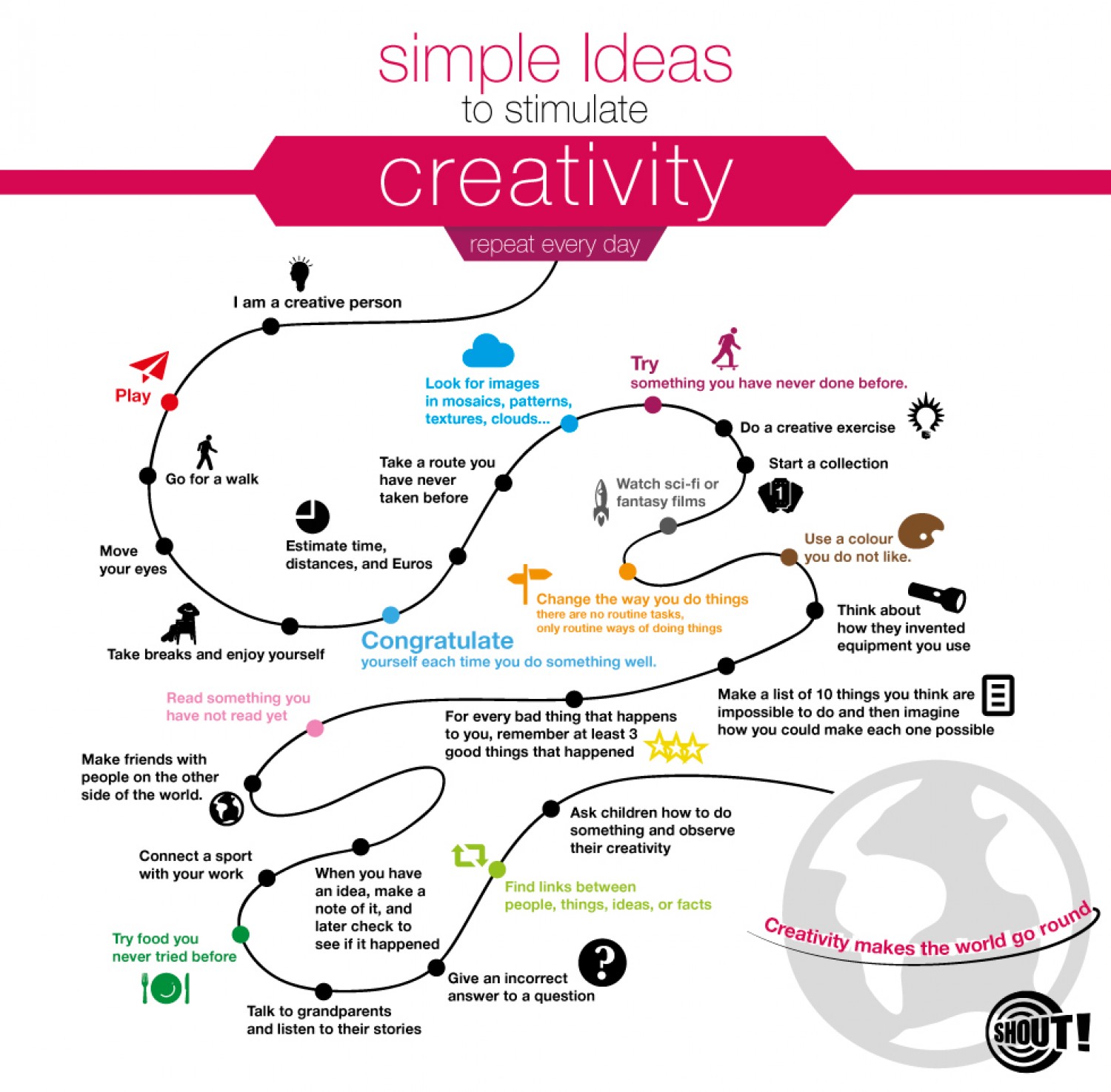
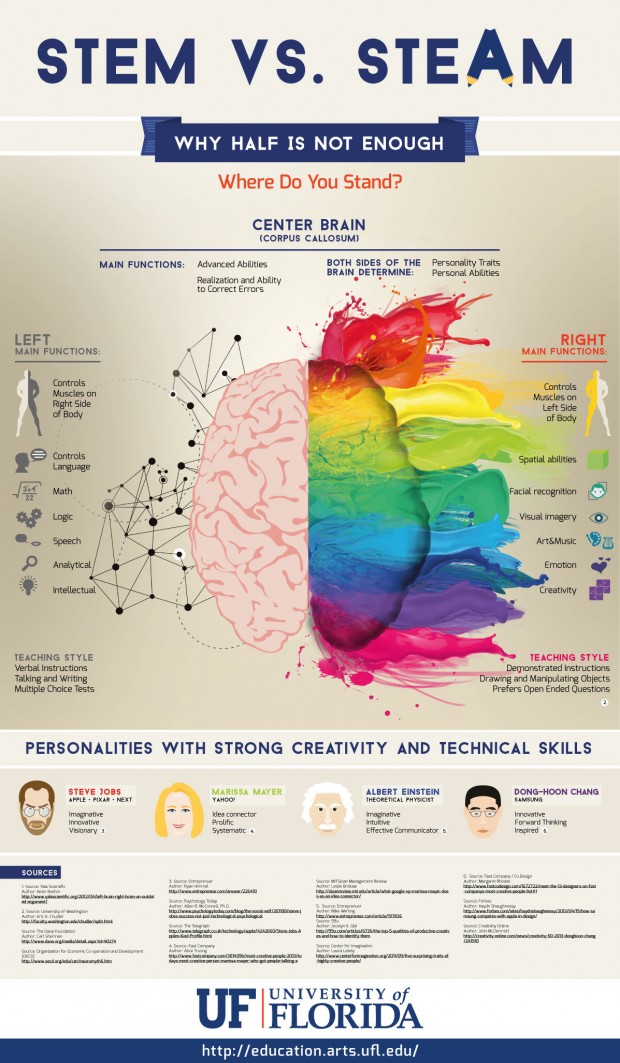
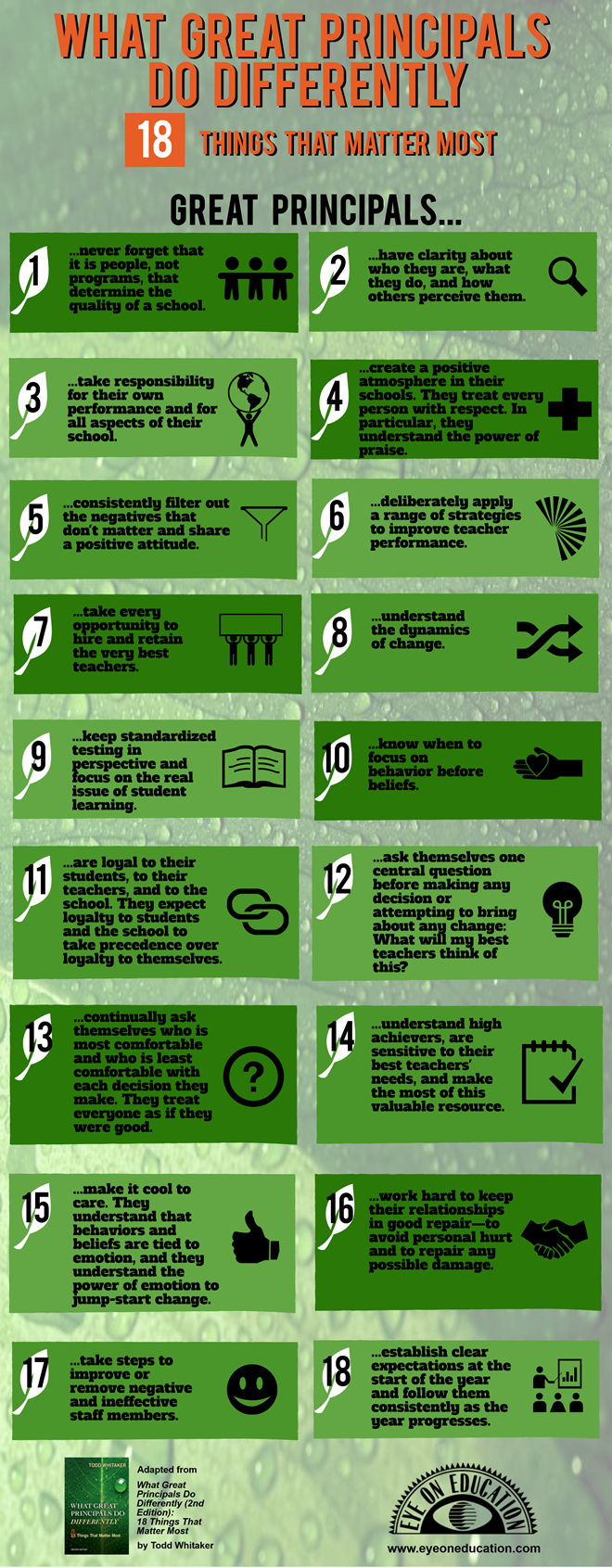




















Acronyms are a natural fit for social media networks. These platforms are based on short and snappy communication, so it makes sense for people to rely on abbreviations, especially for common phrases.
But understanding shorthand isn’t just important for the messages you send. There are social media acronyms that you’ll find in business meetings, in marketing or sales reports, and from your IT team. To be the best at your job, you’ll need to know all of the most common abbreviations.
This list of acronyms can help you stay fresh with the latest lingo, online and off.
To start, it’s probably most helpful to review some of the common acronyms that are tied to specific social media networks. They’re generally intuitive, but you should be sure they’re locked in your brain.
1. FB: Facebook.
2. G+: Google+.
3. IG: Instagram.
4. LI: LinkedIn.
5. YT: YouTube.
There are also a few regularly used acronyms that describe features on those networks. If you’re on Twitter in particular, these are a must-know for improving your communications among team members and with your online audience.
6. DM: A “Direct Message” is a one-on-one message sent on Twitter that is only visible to the two individuals exchanging them.
7. MT: Sometimes when you’re resharing a Tweet, you’ll alter the text. That makes it a “Modified Tweet.” That may mean shortening it to fit within the character limit or removing the poster’s handle if they have a private account.
8. PM: “Private message” is the more general term for any one-on-one communication that’s not visible to the public. It includes DMs.
9. RT: A “Retweet” is when you publish somebody else’s Tweet, in its entirety, to your own feed.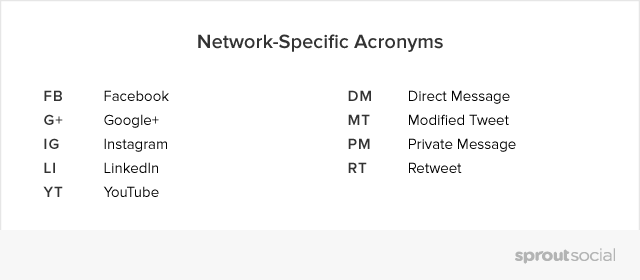
Business experts have always had a unique set of terminology. Many of the general terms that would come up in marketing meetings are equally useful in a social media context.
10. B2B: This “business to business” label refers to companies that are selling to other companies.
11. B2C: On the other hand, “business to consumer” designates a company that is selling to individuals.
12. CMGR: This is the abbreviation for “community manager.”
13. CMS: A “content management system” is the tool you use for editing, scheduling and publishing any written material for the web.
14. CPC: The “cost per click” is the dollar amount an advertiser pays for every person who clicks on an ad.
15. CPM: “Cost per thousand” measures an ad’s impressions rather than its clicks (as in CPC).
16. CR: The “conversion rate” is a simple equation: the number of people who take an action divided by the number who could have.
17. CTA: A “call to action” is a statement that asks the reader to do something. This is usually a specific action related to building the company’s social presence or to getting involved in a marketing push.
18. CTR: The “clickthrough rate” is a particular type of conversion rate where the action in question is clicking on a link.
19. KPI: A “key performance indicator” is a metric your team or business uses to measure success in achieving goals. For social media, this could be a measurement of engagement, conversions, shares or clicks, depending on your purpose in being on those networks.
20. PPC: “Pay per click” is a metric for advertising costs that’s the same as CPC.
21. PV: This stands for “page views.”
22. ROI: “Return on investment” measures the money you make in relation to the money you spent to make it. It’s a way of assessing the success of certain promotional or advertising efforts.
23. UGC: The term “user generated content” encompasses any written or visual material that the individuals using a platform create, from comments or blog posts, to photos or video clips.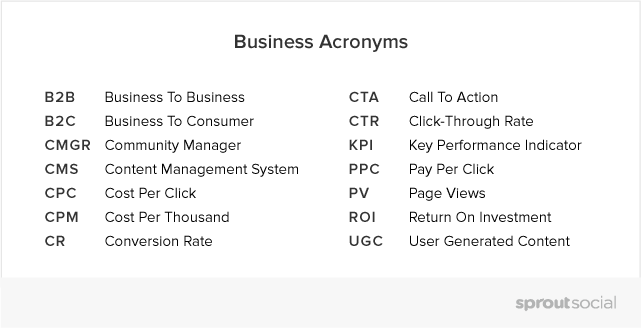
These may not come up frequently in your regular water-cooler chats, but it’s useful for anybody working in social to understand some of the most relevant technical abbreviations. These cover a range of acronyms related to online business that could come up in a chat with the IT team or when dealing with a customer support ticket. In either case, you don’t want to be nodding along without knowing what’s being discussed.
24. API: An “application programming interface” is a set of rules for how pieces of software interact. Your social media management tools use the APIs of Facebook, Twitter and the other networks to post and schedule.
25. ESP: Your “email service provider” is the software used for sending emails. This can be an outside service used for email blasts to your audience or for powering your internal team communications.
26. HTML: You see these letters all the time, and they stand for “hyper text markup language.” It’s the coding language used to build all webpages.
27. ISP: Just as the ESP is the business supplying your email needs, your “Internet service provider” is the company powering your Internet service.
28. RSS: A “really simple syndication” is a feed of all posted content from a source, usually a blog.
29. SaaS: This is an abbreviation for “software as a service,” which is a subset of companies that are in the business of providing software programs.
30. SEM: “Search engine marketing” is how businesses leverage search engines for marketing purposes.
31. SEO: “Search engine optimization” is a form of SEM. It refers to the choices you make in your written content that are designed to make sure that your creations appear high in the rankings of the correct search terms.
32. TOS: “Terms of service.” Just about any online service, including social networks, has a Terms of Service that you must agree to in order to use it. Marketers will want to keep an eye out for any limitations on business activity and details about ownership, both of your content and your data.
33. UI: The “user interface” is the display that a person uses to control a tool.
34. UX: The “user experience” is a person’s response and reaction to taking actions within a tool.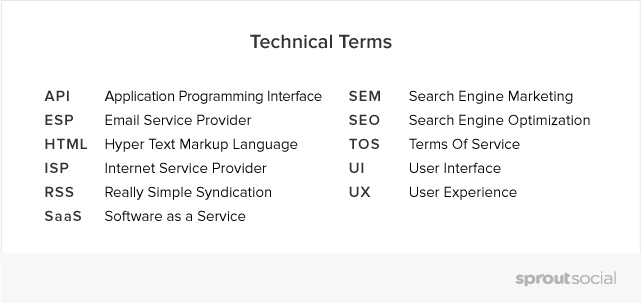
Many of these acronyms crossed over into social media from texting or from online shorthand used in forums. Some of them have been bandied around the Internet for years, but others are more modern inventions. You’ll most likely find these in the public posts made and shared by your followers, or in their comments on your social content. Some of them also get turned into popular hashtags that individuals and brands alike can take advantage of.
35. AFAIK: Stands for “as far as I know.”
36. AMA: Stands for “ask me anything.” Often used to signal an open Q&A opportunity on a social channel.
37. BAE: This abbreviation means “before anyone else,” and is one of the more recent creations. Typically it refers to a person’s significant other, but could be a very close friend as well.
38. BFF: A throwback to childhood in the 80’s and 90’s, this still stands for “best friends forever.”
39. BRB: “Be right back.” This comes up most often in the context of real-time messaging or chat services.
40. BTW: Stands for “by the way.”
41. FBO: Stands for “Facebook official.” This most often refers to making a public announcement of a life development, such as a new job or new relationship, on Facebook to your entire social audience.
42. FF: The “follow Friday” trend began as a Twitter hashtag for recommending people who merit attention on social. These days, most users don’t make this a weekly update, but save it for giving a signal boost to especially interesting or important social profiles.
43. FOMO: Stands for “fear of missing out.”
44. FTW: This acronym of “for the win” initiated in the gaming world, but has become a cry of victory or success for all.
45. FYI: “For your information.” Another classic that’s still in frequent rotation.
46. GTG: “Got to go” can end a conversation.
47. ICYMI: “In case you missed it” most frequently is used when sharing content that is not current. That could be a news item from a few days prior or an evergreen blog post that you want to return to circulation.
48. IDC: Stands for “I don’t care.”
49. IDK: Stands for “I don’t know.”
50. ILY: Stands for “I love you.”
51. IMHO: This acronym means “in my humble opinion.”
52. IMO: A slightly different take, this means simply “in my opinion.”
53. IRL: This acronym means “in real life,” and is meant to distinguish between people’s online and offline lives.
54. JK: This phrase is “just kidding,” and can be helpful in conveying a light-hearted tone when there’s a possibility for a statement to be misconstrued.
55. LMAO: Stands for “laughing my a** off.” Not always the right phrase for a business context, but makes it just as necessary to know this acronym when you see it.
56. LMK: Stands for “let me know.”
57. LOL: A well-used phrase from the beginning of online chat culture, this means “laughing out loud.”
58. NBD: Stands for “no big deal.”
59. NM: Stands for “not much.”
60. NVM: Stands for “never mind.”
61. NSFW: The label “not safe for work” usually designates material that is violent, sexual or otherwise inappropriate for a professional setting.
62. OH: Stands for “overheard.” Generally used as context for quotes.
63. OMG: Stands for “oh my god” or “oh my gosh.”
64. OMW: Stands for “on my way.”
65. PODT: Commonly used as a hashtag on image-centric networks, this stands for “photo of the day.”
66. PPL: This is shorthand for “people.”
67. QOTD: Another frequent hashtag, this one means “quote of the day.”
68. ROFL: A close relative of LOL and LMAO, this acronym is “rolling on the floor laughing.”
69. SMH: This stands for “shaking my head” and is most frequently used to express shock or dismay.
70. TBH: Stands for “to be honest.”
71. TBT: If you’re sharing an old photo, you’ll most likely want to use the hashtag for “throwback Thursday.” Just make sure you post on the right day of the week!
72. TIL: Stands for “today I learned.”
73. TL;DR: This unusual acronym means “too long; didn’t read.”
74. WTF: Another salty shorthand, this stands for “what the f***.”
75. YOLO: The phrase originated in a song by rapper Drake, but the acronym of “you only live once” has also caught on in social communication.

In his SOTU, President Obama proposed making community college tuition free for two years
Michael Horn: We need a better strategy for skills training before going down the track of subsidizing students
“Michael B. Horn is co-founder of the Clayton Christensen Institute for Disruptive Innovation and executive director of its education program. He is author of “Blended: Using Disruptive Innovation to Improve Schools” and “Disrupting Class: How Disruptive Innovation Will Change the Way the World Learns.” The opinions expressed in this commentary are solely those of the author.”
(CNN)In his State of the Union address, President Obama proposed making community college tuition free for two years to boost college graduation rates and lift more people into the middle class.
Unfortunately, his plan doesn’t make the grade. The proposal would not only pile up more debt by further subsidizing runaway college costs, it would also perilously undercut the emergence of more innovative educational programs designed to help students succeed in the workforce.
Offering only a lukewarm pathway to the job market, community colleges are incapable of fulfilling the President’s lofty ambitions. Although there are some high-performing community colleges and stellar stories of success for certain students, the overall picture of success at two-year community colleges is dismal.
According to the Community College Research Center at Teachers College, Columbia University, only 22% of students graduate within three years, and 28% graduate within four. More telling, 80% of students say they want a bachelor’s degree or higher, and yet only 20% of these students transfer to a four-year institution within five years.
Even for those who earn a community college degree, it often isn’t as useful as other options. Thanks to credential inflation, pursuing a professional certification — which more clearly indicates a person’s skills than a degree — often pays off better than an associate’s degree, according to Census Bureau data.
The conversation around making community college free also masks a larger problem, which is that community colleges are already heavily subsidized and far less affordable than commonly believed.
At $3,300, community college tuition is well under the $5,730 currently available in Pell Grant aid to low-income students. But the expenditure per student at a community college — the true cost of the education — is far higher, about four times more at $13,000 per student. That means that more than 60% of the cost of community college isn’t paid for through tuition, but through various forms of government aid at the federal, state and local levels.
As a result, even if the President’s plan passed, it wouldn’t help the large number of already-overcrowded community colleges that have waiting lists numbering in the thousands. Tuition is only a small part of the funding needed to educate additional students.
What’s more, because of the limited productivity gains possible in the community college model, those costs will continue to rise, which means that tuition will, too. The proposal’s $60 billion price over 10 years is likely to grow with only a questionable return on the investment.
Opinion: Two years of free community college makes sense
The larger question the proposal misses is not how to allow students to afford college, but how to make college affordable. There’s a huge distinction. The focus should be to make postsecondary education less costly and of better quality, such that the question of how to afford it becomes manageable. The President’s proposal merely charges education, in the form of debt for future generations of taxpayers, rather than changes it.
Instead we need to encourage students to seek innovative offerings that are lower cost and improve the quality and accessibility of higher education.
Such options are emerging. Patten University offers a new online, competency-based program that charges undergraduate tuition of $350 per month, or $1,316 per term. Tuition includes access to as many courses as one can complete and all the ebooks and course materials needed, and Patten receives no government funding. Another online, competency-based program, Southern New Hampshire’s College for America, charges annual tuition of $2,500.
Rather than supporting innovative options like Patten and Southern New Hampshire, the President’s plan would nudge students toward a community college sector that is incapable of repositioning its model around student success and fuel rising college costs.
5 ways community colleges are fixing higher education
If enacted, the President’s proposal would be unlikely to achieve its ultimate aims and would exacerbate a larger problem lurking behind college financing. Although the plan amounts to little more than political posturing given the current congressional makeup, it will negatively influence the political conversation around higher education in the years ahead.
By supporting free community college, President Obama is merely kicking the can down the road for future generations to confront. We need a better strategy for skills training overall before we go further down the track of subsidizing students to attend community college only to emerge with little to show for it.

Now that we’ve posted our first few articles in our Technology 101 for Parents Series, I’ve been noticing many of the comments from parents frustrated by the constant struggle technology seems to present in their families. Here are some of the most common things I’ve heard parents say over the last few weeks:
“I can’t get my kids to stop playing on their DS/Wii/Playstation/iPad/Phone”
“Anytime I tell them to turn it off, it turns into a major battle”
“It feels like technology is taking over our lives”
While I absolutely sympathize and I understand how managing technology and our kids can feel overwhelming for parents, we really do have the ability to take control of technology before technology takes over our families.
Step 1
Well, I think there is an obvious starting place for this conversation – it’s us parents. Before we can even begin to help our children to make wise choices when it comes to technology use, we have to ask ourselves exactly what behaviors are we modeling? If we aren’t exercising discipline and we’re constantly on our devices, we can’t expect anything different from our children.
Step 2
We need some basic rules and boundaries that we’ve actually discussed with our kids and that we are sure they understand. So, here are some “house tech rules” that should help tame the technology monster that has taken over your household. (there’s a super cute printable at the end of the post. Hang it over your family computer or on the fridge to serve as reminder for your kids and for you)
1. Technology is a Privilege Not a Right
As parents we ARE obligated to provide some basics to our children. These are their rights as our children and include things like food, shelter, clothes, a K-12 education and our love. Nowhere in the parent agreement does it state we MUST provide them with a TV, an iPhone, an iPad, a Computer, two different gaming systems with games for each and endless hours utilizing these various technologies. Those are NOT rights.
I have told my children for several years now, “your expectation for technology time should be zero, anything you get above that should be considered a privilege.” Then I make a cute little “zero” with my hands together kind of like the little hand hearts young people like to make these days. This helps them to understand that having technology available and being given the opportunity to use it is not an automatic, they have to hold up their end of being part of our family or else technology is the first thing to go. It also helps them to be appreciative of technology time when they have it.
2. All Technology Must Be Parent Approved
Whether it’s watching a certain television show, downloading a new app, using our family computer (which sits in our open living room by the way so we can always monitor them on it) or purchasing a new video game, they MUST ask our permission. If they do not, and this includes at other people’s houses, and we find out then it results in a TOTAL loss of all technology. Each family has to determine for themselves the length of the time-out from tech based on the offense, but this is a zero tolerance policy and we as parents should NEVER make an exception.
If you are unsure about whether or not something is appropriate for your child – A simple visit to Common Sense Media should provide you with all the info you need.
3. We Value People More Than Technology
How often has your child completely ignored a request you’ve made b/c they are zombified by the TV or else maybe you’ve heard your children using unkind words when they are playing a video game with a friend or sibling. Our children need to be taught to value their relationships and that those relationships should always be put first.
If my child fails to respond to me, because they are too absorbed in technology, then the technology gets turned off for the rest of the day and sometimes the rest of the week.
When it comes to how we treat people when technology is involved, whether it’s smack talk gone too far when playing video games or for older kids it could be using texting or social media to be cruel to another child, I once again will remove the technology at that moment. However, we will talk about why they made the choices they did and how to be better next time. If the behavior becomes repetitive, then we “take a break” for a determined amount of time until they can prove they are deserving of another opportunity.
4. Devices Don’t Come to the Dinner Table
Period. End of Story. The End. This is the best chance we have as parents to connect with our children and find out what is going on in their lives. If everyone is too busy with tech, then we lose out on this important family time.
5. There is No Tech Behind Closed Doors
There is plenty of evidence to support that when children have TV’s, computers and other technology in their bedrooms it is not a great idea. However, this is really a family by family choice. Whatever you choose though, there is NEVER a reason that a child (toddler to teen) needs to have technology of any kind behind a closed door. It simply invites trouble and while most of us want to trust our kids, why provide temptation that isn’t absolutely necessary.
6. Chores and Homework Come Before TV and Video Games
This goes back to technology being a privilege and not a right. Our kids need to be able to put their responsibilities to their family first and also to adopt the work before play principle. This is also a step in teaching our children about priorities and how to put first things first.
7. Turn it Off is NOT a Negotiation
I do not demand my children turn off the TV or quit a game they are playing on our iPad without some warning, this is only fair. I will give at least a five minute notice before I am expecting them to turn it off. However, after the grace period is up, I’ve made it clear that they should not beg for more time, whine and complain, or even worse, have some sort of tantrum. In the event this occurs, no more technology privileges for a set period of time. When they get tech time back, I remind them why they lost it and that they will have the same consequence doubled if it happens again.
8. We Break It We Help Pay to Replace It
Let’s face it, most technology is expensive. It is okay to talk with our kids about the investment made in a purchase and the importance of caring for our possessions properly. For our littles, we need to show them the right and wrong way to handle these different devices and for all our kids there should be an established safe place to put things when they are done using them. If our kids are careless, then they absolutely need to, at a minimum, share the burden of paying for a replacement. For older kids this money can come out of an allowance or savings or they can do extra chores to earn the money to help replace the broken item. Younger children may not be able to monetarily help, but it may mean an item just isn’t replaced or else if it is, they no longer can use it.
9. We Use Technology Appropriately or We Lose It
Using tech in a way that could potentially harm any human being, including oneself is inappropriate. This means you’re going to need to have age appropriate conversations with your child about the dangers that exist online. There needs to be a clear understanding about the language & photos that are acceptable vs. unacceptable to be placed online. Do not assume your child “knows better”, be blunt & state the obvious. We also need to coach them on appropriate social etiquette and how to be respectful online. Children, and many adults, feel a false sense of anonymity when they are interacting with others online and may act in ways or say things that they never would in other situations.
We can have good kids, but that doesn’t mean they will ALWAYS make good decisions. Children do not have fully developed decision making capabilities or the ability to think through their decisions to the long-term consequences even in their teens. That is why they are ours until they are at least 18. If they do not demonstrate the maturity necessary to handle different aspects of technology appropriately, then they don’t deserve to have the technology. Both for their safety and the safety of others. Don’t be afraid to be the bad guy, you know your child better than anyone and it is your job to be their parent, not their friends.
Below you will find a link for this Family Technology Rules Printable. We will also be publishing another post in the Technology 101 for Parents Series soon geared towards older children and establishing a family technology contract. You won’t want to miss it, so be sure to sign up for our weekly email newsletter: http://eepurl.com/WXOv5

Illustration by Alex Eben Meyer
Ours is an age of pedagogy. Anxious parents instruct their children more and more, at younger and younger ages, until they’re reading books to babies in the womb. They pressure teachers to make kindergartens and nurseries more like schools. So does the law—the 2001 No Child Left Behind Act explicitly urged more direct instruction in federally funded preschools.
There are skeptics, of course, including some parents, many preschool teachers, and even a few policy-makers. Shouldn’t very young children be allowed to explore, inquire, play, and discover, they ask? Perhaps direct instruction can help children learn specific facts and skills, but what about curiosity and creativity—abilities that are even more important for learning in the long run? Two forthcoming studies in the journal Cognition—one from a lab at MIT and one from my lab at UC-Berkeley—suggest that the doubters are on to something. While learning from a teacher may help children get to a specific answer more quickly, it also makes them less likely to discover new information about a problem and to create a new and unexpected solution.
What do we already know about how teaching affects learning? Not as much as we would like, unfortunately, because it is a very difficult thing to study. You might try to compare different kinds of schools. But the children and the teachers at a Marin County preschool that encourages exploration will be very different from the children and teachers in a direct instruction program in South Side Chicago. And almost any new program with enthusiastic teachers will have good effects, at least to begin with, regardless of content. So comparisons are difficult. Besides, how do you measure learning, anyway? Almost by definition, directed teaching will make children do better on standardized tests, which the government uses to evaluate school performance. Curiosity and creativity are harder to measure.
Developmental scientists like me explore the basic science of learning by designing controlled experiments. We might start by saying: Suppose we gave a group of 4-year-olds exactly the same problems and only varied on whether we taught them directly or encouraged them to figure it out for themselves? Would they learn different things and develop different solutions? The two new studies in Cognition are the first to systematically show that they would.
In the first study, MIT professor Laura Schulz, her graduate student Elizabeth Bonawitz, and their colleagues looked at how 4-year-olds learned about a new toy with four tubes. Each tube could do something interesting: If you pulled on one tube it squeaked, if you looked inside another tube you found a hidden mirror, and so on. For one group of children, the experimenter said: “I just found this toy!” As she brought out the toy, she pulled the first tube, as if by accident, and it squeaked. She acted surprised (“Huh! Did you see that? Let me try to do that!”) and pulled the tube again to make it squeak a second time. With the other children, the experimenter acted more like a teacher. She said, “I’m going to show you how my toy works. Watch this!” and deliberately made the tube squeak. Then she left both groups of children alone to play with the toy.
All of the children pulled the first tube to make it squeak. The question was whether they would also learn about the other things the toy could do. The children from the first group played with the toy longer and discovered more of its “hidden” features than those in the second group. In other words, direct instruction made the children less curious and less likely to discover new information.
Does direct teaching also make children less likely to draw new conclusions—or, put another way, does it make them less creative? To answer this question, Daphna Buchsbaum, Tom Griffiths, Patrick Shafto, and I gave another group of 4-year-old children a new toy.* This time, though, we demonstrated sequences of three actions on the toy, some of which caused the toy to play music, some of which did not. For example, Daphna might start by squishing the toy, then pressing a pad on its top, then pulling a ring on its side, at which point the toy would play music. Then she might try a different series of three actions, and it would play music again. Not every sequence she demonstrated worked, however: Only the ones that ended with the same two actions made the music play. After showing the children five successful sequences interspersed with four unsuccessful ones, she gave them the toy and told them to “make it go.”
Daphna ran through the same nine sequences with all the children, but with one group, she acted as if she were clueless about the toy. (“Wow, look at this toy. I wonder how it works? Let’s try this,” she said.) With the other group, she acted like a teacher. (“Here’s how my toy works.”) When she acted clueless, many of the children figured out the most intelligent way of getting the toy to play music (performing just the two key actions, something Daphna had not demonstrated). But when Daphna acted like a teacher, the children imitated her exactly, rather than discovering the more intelligent and more novel two-action solution.
As so often happens in science, two studies from different labs, using different techniques, have simultaneously produced strikingly similar results. They provide scientific support for the intuitions many teachers have had all along: Direct instruction really can limit young children’s learning. Teaching is a very effective way to get children to learn something specific—this tube squeaks, say, or a squish then a press then a pull causes the music to play. But it also makes children less likely to discover unexpected information and to draw unexpected conclusions.
Why might children behave this way? Adults often assume that most learning is the result of teaching and that exploratory, spontaneous learning is unusual. But actually, spontaneous learning is more fundamental. It’s this kind of learning, in fact, that allows kids to learn from teachers in the first place. Patrick Shafto, a machine-learning specialist at the University of Louisville and a co-author of both these studies; Noah Goodman at Stanford; and their colleagues have explored how we could design computers that learn about the world as effectively as young children do. It’s this work that inspired these experiments.
These experts in machine learning argue that learning from teachers first requires you to learn about teachers. For example, if you know how teachers work, you tend to assume that they are trying to be informative. When the teacher in the tube-toy experiment doesn’t go looking for hidden features inside the tubes, the learner unconsciously thinks: “She’s a teacher. If there were something interesting in there, she would have showed it to me.” These assumptions lead children to narrow in, and to consider just the specific information a teacher provides. Without a teacher present, children look for a much wider range of information and consider a greater range of options.
Knowing what to expect from a teacher is a really good thing, of course: It lets you get the right answers more quickly than you would otherwise. Indeed, these studies show that 4-year-olds understand how teaching works and can learn from teachers. But there is an intrinsic trade-off between that kind of learning and the more wide-ranging learning that is so natural for young children. Knowing this, it’s more important than ever to give children’s remarkable, spontaneous learning abilities free rein. That means a rich, stable, and safe world, with affectionate and supportive grown-ups, and lots of opportunities for exploration and play. Not school for babies.

Three years ago, technology was going to transform higher education. What happened?
Over the course of a few months in early 2012, leading scientists from Harvard, Stanford and M.I.T. started three companies to provide Massive Open Online Courses, or MOOCs, to anyone in the world with an Internet connection. The courses were free. Millions of students signed up. Pundits called it a revolution.
But today, enrollment in traditional colleges remains robust, and undergraduates are paying higher tuition and taking out larger loans than ever before. Universities do not seem poised to join travel agents and video stores on the ash heap of history — at least, not yet.
The failure of MOOCs to disrupt higher education has nothing to do with the quality of the courses themselves, many of which are quite good and getting better. Colleges are holding technology at bay because the only thing MOOCs provide is access to world-class professors at an unbeatable price. What they don’t offer are official college degrees, the kind that can get you a job. And that, it turns out, is mostly what college students are paying for.
Now information technology is poised to transform college degrees. When that happens, the economic foundations beneath the academy will truly begin to tremble.
Traditional college degrees represent several different kinds of information. Elite universities run admissions tournaments as a way of identifying the best and the brightest. That, in itself, is valuable data. It’s why “Harvard dropout” and “Harvard graduate” tell the job market almost exactly the same thing: “This person was good enough to get into Harvard.”
Degrees give meaning and structure to collections of college courses. A bachelor’s degree signifies more than just 120 college credits. To graduate, students need a certain number of upper- and lower-division credits, a major and perhaps a sprinkling of courses in the sciences and humanities.
College degrees are also required to get graduate degrees. It didn’t used to be that way. Back in the 19th century, people interested in practicing law could enroll directly in law school. When Charles Eliot became president of Harvard in 1869, he set to work making bachelor’s degrees a prerequisite for admission to Harvard’s graduate and professional schools. Other colleges followed suit, and by the turn of the century a large and captive market for their educational services had been created.
Most important, traditional college degrees are deeply embedded in government regulation and standard human resources practice. It doesn’t matter how good a teacher you are — if you don’t have a bachelor’s degree, it’s illegal for a public school to hire you. Private-sector employers often use college degrees as a cheap and easy way to select for certain basic attributes, mostly the discipline and wherewithal necessary to earn 120 college credits.
Free online courses won’t revolutionize education until there is a parallel system of free or low-fee credentials, not controlled by traditional colleges, that leads to jobs. Now technological innovators are working on that, too.
The Mozilla Foundation, which brought the world the Firefox web browser, has spent the last few years creating what it calls the Open Badges project. Badges are electronic credentials that any organization, collegiate or otherwise, can issue. Badges indicate specific skills and knowledge, backed by links to electronic evidence of how and why, exactly, the badge was earned.
Traditional institutions, including Michigan State and the University of Illinois at Urbana-Champaign, are experimenting with issuing badges. But so are organizations like the National Oceanic and Atmospheric Administration, 4-H, the Smithsonian, the Dallas Museum of Art and the Y.M.C.A. of Greater New York.
The most important thing about badges is that they aren’t limited to what people learn in college. Nor are they controlled by colleges exclusively. People learn throughout their lives, at work, at home, in church, among their communities. The fact that colleges currently have a near-monopoly on degrees that lead to jobs goes a long way toward explaining how they can continue raising prices every year.
The MOOC providers themselves are also moving in this direction. They’ve always offered credentials. In 2013, I completed a semester-long M.I.T. course in genetics through a nonprofit organization run by Harvard and M.I.T., called edX. You can see the proof of my credentials here and here.
Coursera, a for-profit MOOC platform, offers sequences of courses akin to college majors, followed by a so-called capstone project in which students demonstrate their skills and receive a verified certificate, for a fee of $470. The Coursera Data Science sequence is taught by Johns Hopkins University and includes nine four-week courses like exploratory data analysis, regression models and machine learning. The capstone project requires students to build a data model and create visualizations to communicate their analysis. The certificate is officially endorsed by both Coursera and Johns Hopkins. EdX has similar programs.
Inevitably, there will be a lag between the creation of such new credentials and their widespread acceptance by employers and government regulators. H.R. departments know what a bachelor’s degree is. “Verified certificates” are something new. But employers have a powerful incentive to move in this direction: Traditional college degrees are deeply inadequate tools for communicating information.
The standard diploma has roughly the same amount of information that prisoners of war are required to divulge under the Geneva Conventions. College transcripts are a nightmare of departmental abbreviations, course numbers of indeterminate meaning, and grades whose value has been steadily eroded by their inflation.
This has the effect of reinforcing class biases that are already built into college admissions. A large and relatively open-access traditional public university might graduate the same overall number of great job candidates as a small, exclusive, private university — say, 200 each. But the public 200 may graduate alongside 3,000 other students, while the private 200 may have only 300 peers. Because diplomas and transcripts provide few means of reliably distinguishing the great from the rest, employers give a leg up to private college graduates who probably had some legs up to begin with.
Open credentialing systems allow people to control information about themselves — what they learned in college, and what they learned everywhere else — and present that data directly to employers. In a world where people increasingly interact over distances, electronically, the ability to control your online educational identity is crucial.
This does present a new challenge for employers, who will have to sift through all this additional information. College degrees, for all of their faults, are quick and easy to digest. Of course, processing large amounts of information is exactly what computers are good for. Scientists at Carnegie Mellon University are designing open badges that are “machine discoverable,” meaning that they are designed to be found by employers using search algorithms to locate people with specific skills.
Protecting private, personal information is a big part of navigating the digital era. But people want certain kinds of information to be as public as possible — for example, that they are very good at specific jobs and would like to find an employer looking for such people. Companies such as LinkedIn are steadily building new tools for people to describe their employable selves. College degrees, by contrast, say little and never change.
In the long run, MOOCs will most likely be seen as a crucial step forward in the reformation of higher education. But their true impact won’t be felt until students and learners of all kinds have access to digital credentials that are also built for the modern world. Then they’ll be able to acquire skills and get jobs for a fraction of what colleges cost today.

CHICAGO — A few years ago, 4-year-old Danny was on the verge of being expelled from a Chicago preschool for violent behavior when a woman named Lauren Wiley was called in to help.
She met with the boy’s teacher, who thought he needed to be medicated for attention deficit disorder. But as Wiley listened, the teacher admitted she was angry at Danny, whose name has been changed to protect his identity. Her job was to keep her students safe, she said, and the boy’s aggression made her feel like a failure. Next, Wiley and the teacher met with Danny’s mom. As the teacher dropped her judgmental attitude, it came out that Danny had watched his father beat his mother and get taken away in handcuffs. No one had ever talked to the child about what he saw. He did not have ADD. He was reeling from trauma, and he needed his teacher to like him and want to help him, not to be rid of him. That began to happen when she heard his story.
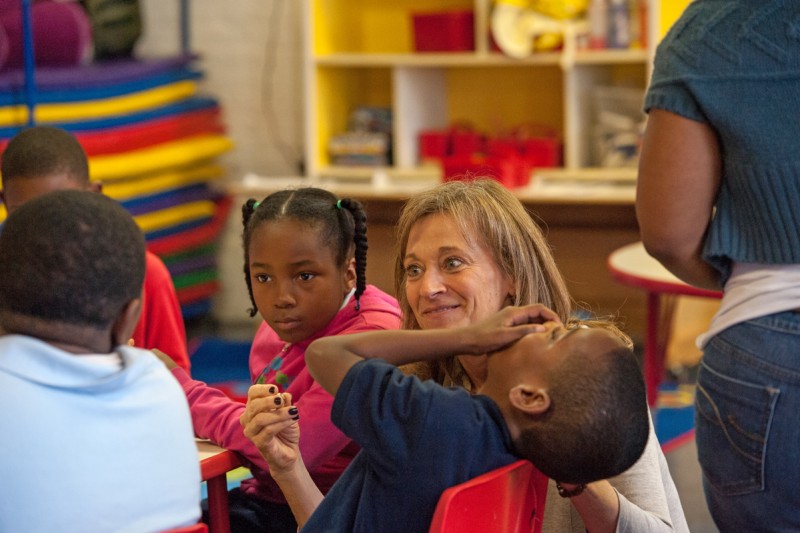
An after-school program run by Chicago Youth Centers has seen significant improvement in children’s behaviors since staff began working with Lauren Wiley, an early childhood mental health consultant.
Wiley is an early childhood mental health consultant. The job title often evokes an image of a baby on a couch talking to a therapist, but her work is about listening to adults so they can create an emotionally healthy environment for children. She trains teachers and others who work with young children to recognize the trauma that so often causes misbehavior. She supports them in confronting cultural biases and forging relationships with parents. She shows them how to recognize families’ strengths and promote mental wellness before problems develop. This is particularly significant since we know that “adverse childhood experiences” like violence and family dysfunction predict everything from academic failure to cancer to heart disease.
In 2005, Yale professor Walter Gilliam shocked the nation with the first research showing that preschoolers are expelled at three times the rate of children in kindergarten through 12th grade. He showed that young African-American boys like Danny are most vulnerable to what he calls “the capital punishment of schools.”
Gilliam convened focus groups of teachers to find out why, in mixed-age classes, he was seeing 4-year-olds expelled at higher rates than 3-year-olds in the same rooms. The replies were consistent: The teachers perceived the 4-year-olds as more likely to hurt someone when they misbehave because they are physically bigger.
“That’s when it dawned on me that expulsion is not a child behavior. It’s an adult decision,” said Gilliam, who spoke on the topic at a Dec. 10 White House summit on early childhood education.
He realized that, for the problem to get better, teachers need help managing challenging behavior.

As an early childhood mental health consultant, Lauren Wiley travels around the state of Illinois to various settings serving young children. At this after-school program run by Chicago Youth Centers, she works with students older than her usual clientele of birth to 5.
Gilliam has zeroed in on the consultation intervention as a particularly promising and cost-effective approach: In a Connecticut study, he found that it reduces preschool expulsions by half. It also has been shown to improve the emotional well-being of all children in the pivotal years before kindergarten and boost staff retention and job satisfaction in an industry with rampant turnover.
With that research base from preschools, consultation now is being tried in home visiting programs, domestic violence shelters, pediatrician’s offices — anywhere that serves young children. There are also early efforts to bring a similar service to older kids.
Under the nation’s newly reauthorized child care funding legislation, states must develop plans to reduce preschool expulsions, and consultation is now an allowable expense. The U.S. Department of Health and Human Services announced $4 million in December to expand the intervention’s reach. Head Start and Early Head Start programs already require it, and there are about a half-dozen state programs, as well as numerous regional ones. Still, the vast majority of early childhood settings do not have routine access to consultants, according to Georgetown professor Deborah Perry, who directed the National Center for Early Childhood Mental Health Consultation.
Related: The earliest intervention: How to stop the achievement gap from starting?

Lauren Wiley (right), an early childhood mental health consultant, guides a teacher to talk to a girl about her emotions at an after-school program run by Chicago Youth Centers.
I recently spent two days shadowing Lauren Wiley in Illinois, one of the places with a statewide program. She’s a petite 55-year-old who puts 500 to 700 miles a week on her silver Acura, a distance she says is only possible because her own two kids are grown. One of our stops was in Chicago’s violent North Lawndale neighborhood at an after-school program in an immaculately-kept old building with a “no firearms” sticker on the door. Wiley had made weekly visits there since early 2014 to address the mental health needs of students ages 7 to 11, older than her usual clientele.
She had been encouraging the program’s director and two teachers to focus on what the children can do, not what they can’t. This simple strategy led the staff to uncover one troubled 11-year-old’s love of verbal storytelling. By asking him to tell and then illustrate the story of his life — which includes frequent neighborhood shootings, a recent murder on his block and teasing for a minor facial deformity — he took an interest in writing his life story as well. As a result, he is reading for the first time, and mortifying accidents wetting his pants are far fewer. A handmade poster lists his coping strategies: “deep breaths,” “fan myself,” “take a time out,” “sit quietly by myself.”
On the day we visited, the teachers watched as Wiley had the eight children present decorate boxes to fill and empty with small bells based on acts of kindness and cruelty. She noticed a few coloring in red and then trying to erase it and perceived the imagery of a blood stain that won’t come out. She prodded a teacher to pull a little girl aside to talk.
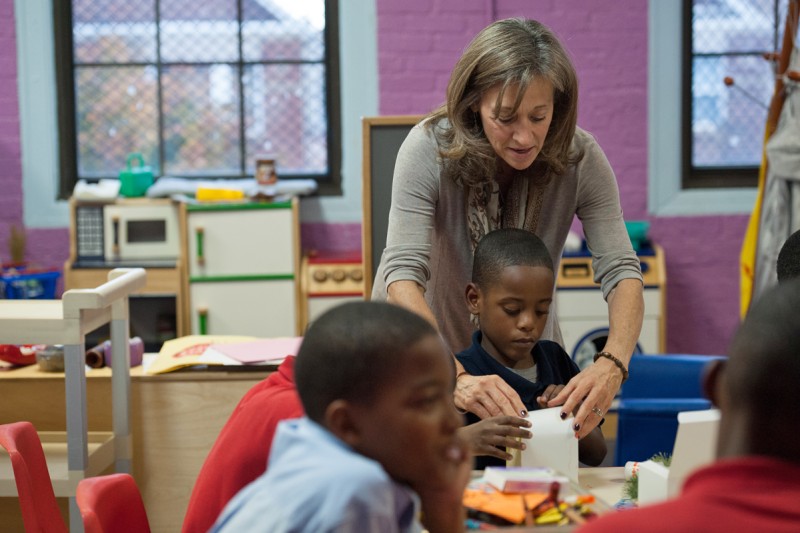
Lauren Wiley helps a boy decorate a box he will fill and empty with small bells based on acts of kindness and cruelty in his life.
Early childhood mental health consultation can look like this, with a consultant and teacher working together with children, modeling lessons for each other. Or it can just look like adults sitting around a table, as we saw at a day care, where a conversation about suspected parental drug use led Wiley to a bigger probe: Do all staff members believe the mothers they serve can be good parents? While no one wanted to admit bias, and Wiley never acts like she has all the answers, she had clearly unearthed a problem, and a fundamental one. Child care and preschool expulsions are virtually unheard of when the teacher and parent know and like each other.
Sometimes, consultants can offer relatively simple fixes. According to Georgetown’s Perry, teachers make the common mistake of giving directions while standing up; young children, particularly those with concentration difficulty, are more likely to listen to an adult at their eye level. Consultants watch how teachers navigate activity changes — think taking a dozen 3-year-olds to the bathroom — since those are the most common times for behavioral outbursts to occur. They suggest things like signing a clean-up song every day so kids will anticipate and understand routines.
More difficult are the situations requiring changes in adult attitudes and habits, and that’s where Wiley spends most of her time. She said it is common for home visitors to pick up and calm fussy babies, alienating mothers who don’t know how to soothe them or have traumatic memories tied to their own childhood cries. In an agency focused on mental wellness, she said, the home visitor might instead put an arm around the insecure mom holding her baby and tell her: “When I’m not here, I want you to remember that I’m with you. My arm is around you. You can do it.”
Related: The power of preschool done right
The consensus is that effective consultation must include supervisors, both to support staff on the front lines and so that when there is turnover, the work isn’t all lost. Wiley says she needs to be in a place at least a year, and preferably two, to shift an organization’s mindset. Results for individual children and classrooms can happen faster, but Wiley gets incensed when her peers address what she calls the “low-hanging fruit” — a child’s misbehavior — without training the staff what to do. She sees her role as creating a safe space for early childhood professionals to reflect and explore ideas. “The hardest part is sitting with your own discomfort sometimes while people figure it out for themselves,” she said.
Wiley is an independent contractor. Many of her assignments come from the Illinois Children’s Mental Health Partnership, an agency the state created in 2003 in response to research showing that more than 20 percent of children have a diagnosable mental health condition, but only one in five of those are treated.

Regina Le Flore, owner of Little People Montessori in Lyons, Ill., says she would love more strategies to help children with significant behavior problems stay enrolled at her center.
The partnership has received $200,000 a year in state money to provide early childhood mental health consultation free to any agency that requests it, as capacity allows, along with $270,000 in federal money to consult in home visitation programs. By conservative estimates, it reached 59 programs last fiscal year with the state funds and used the federal dollars to serve 139 home visitors and supervisors serving 1,490 families. A little money has gone a long way, and other organizations receive government funding for similar services. But with resources few and needs great, the work is not heavily promoted, and many who could benefit don’t know it exists.
Regina Le Flore, who owns a Montessori day care and preschool in the western Chicago suburb of Lyons, said she would love for her teachers to have more training in what to do when children develop significant behavior problems. That typically happens once or twice a year and usually results in their withdrawal, often with their parents acting defensive when the staff suggests the child needs counseling. (A consultant would recommend avoiding accusations that can make a parent feel like a failure.)
Related: A grandmother’s quest to overcome early learning barriers
To take consultation to scale, those in the field agree there needs to be a model delineating what quality looks like and a bigger workforce with a rare combination of skills: experience as a mental health professional, knowledge of child development, cultural awareness, and an understanding of families and of trauma. But those things would come if there were steady government funding.
Wiley, an Illinois native who lives 60 miles south of Chicago in a small town called Bourbonnais, is one of the most seasoned consultants in the state, with more than a decade of experience. She says her greatest asset is curiosity, a trait she tries to get her clients to adopt in their interactions with families.
When Danny’s teacher dropped her assumption about what was wrong and listened receptively to his mother, the whole situation shifted. They worked together to find a classmate he could play with quietly, to let him change activities when he couldn’t focus and to help his mother say goodbye when she dropped him off each morning. Earlier, she would sneak away because she couldn’t handle watching him melt down.
And one moment at a time, supportive adult behavior paved the way for a child to remain in school.
This story was produced by The Hechinger Report, a nonprofit, independent news organization focused on inequality and innovation in education. Read more about early childhood education.
A version of this story was published by The New York Times on Feb. 20, 2014.
Reproduction of this story is not permitted.
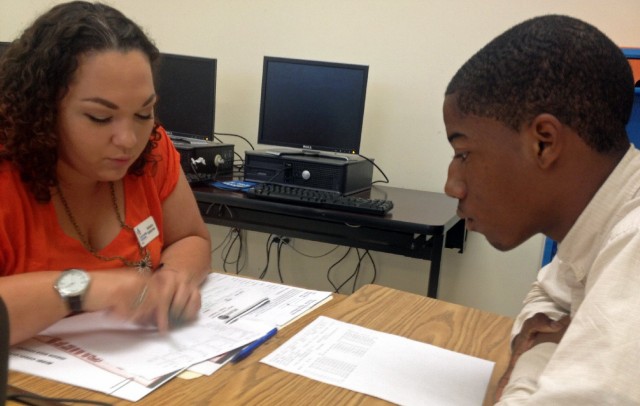
By Sammy Mack
At Miami Carol City Senior High in Florida, a handful of teachers, administrators and coaches are gathered around a heavy wooden table in a conference room dubbed the “War Room,” looking through packets of information about several students.
There are others at the table, too: analysts from the group Talent Development Secondary, which monitors student data; City Year, a nonprofit that provides mentors; and Communities in Schools, which connects kids with health care and social services.
It’s a lot of cooks in the kitchen, but they’re all here to help students who are just starting to show signs of trouble.
The process works like this: analyst Jennifer Savino gathers information on attendance, behavior and performance in math and English. Then, based on some dropout risk studies from Johns Hopkins University, she flags kids who are on a downward trend. Those names show up on PowerPoint slides at these weekly War Room meetings.
Today, there are three kids on the list. A projector beams one student’s image on a screen, accompanied by a spreadsheet of his grades so far this year. His most recent report card shows a lot more D’s and F’s than in the first part of the year.
“He came to me last week and he said, ‘I’m hungry. I haven’t had anything to eat all day,’ ” says one teacher. “I had a bag of chips and I gave them to him.”
“If that happens again … we keep snacks in the office,” offers another.
A third person points out something not everyone knows about this student: Turns out, he’s spent more than a week this semester living in a car.
The team then discusses some potential options, like strategies for helping the student manage his time and putting him in touch with homeless services. A sports coach volunteers to coordinate everything.
This kind of interaction between different school departments didn’t happen before.
“If we don’t get to the core of the problem, we can’t teach them,” says Tracy Troy, who teaches math and special education.
USING DATA TO CREATE EARLY WARNING SYSTEM
When these meetings were first introduced three years ago, Troy, who has been on staff at Carol City for 14 years, was apprehensive about getting involved with students’ problems outside her classroom.
“Not that I don’t care, but I care too much,” she says. “And sometimes, it weighs on you. Because those are your children while you’re here.”
Now, she says, the War Room meetings help her help the kids.
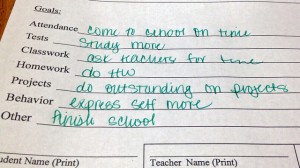
The program, called Diplomas Now, identifies 150 to 200 students a year at Carol City. It costs about $600 per student annually to run.
Last school year, one-third of students flagged for missing school got back on track to graduation. Two-thirds of the students who were having behavioral problems made a turnaround.
“The point of all this isn’t to collect data. It’s to change what’s happening for individual kids,” says Paige Kowalski, a state policy director for the Data Quality Campaign, a group that advocates for better use of all that student information the states collect.
Kowalski says about 20 states have developed early warning systems like the one here at Carol City. Schools, she says, can learn a lot from the medical field, in particular.
“[They] don’t just put out reports saying, ‘The hospital lost all these patients and saved these people,’ ” she says. “They actually look at it and say, ‘What can we do better?’ ”
FINDING KIDS WHO MIGHT GET MISSED
Earlier this year, Mack Godbee, a soft-spoken Carol City High 10th-grader, was the subject of a War Room meeting. The first quarter of the school year, Godbee’s report card was littered with D’s and F’s.
Today, it’s report card time again, and Godbee is going over his most recent grades with his mentor, Natasha Santana-Viera. Now, there are more C’s and B’s, and he got an A in English.
Godbee says his life would be very different if he had not participated in the Diplomas Now program. “No lie — I think I would have ended up dead,” he says.
That’s because he was spending a lot of time on the street. When his dad left home, he explains, he wanted to show his mom that they didn’t need him. So Godbee started selling drugs. He was 6.
By the time he got to high school, Godbee says, he was affiliated with a gang. He skipped classes, didn’t study and was angry all the time.
That might have been easy for teachers and administrators to miss. But earlier this school year, after looking at Godbee’s data, Santana-Viera sat him down and asked, “Are you OK?”
“I sat right there and thought about it. Like, am I really OK?” Godbee recalls.
And for the first time in his life, he said no.
Even with his improvements this year, Godbee doesn’t want to be the person he is now. “I want to be a different person. I want to be that kid that makes straight A’s and B’s on his report card,” he says. “Be in school every day on time. Be on that honor roll list. Go on field trips.”
Godbee has a lot to work on, but according to the data, he’s on an upward trend.

A Hawaii-based company this week accused Oculus Rift and its founder Palmer Luckey of building its virtual reality hardware company with information stolen from its own research and development.
The lawsuit, filed on Wednesday, says that Ron Igra and Thomas Seidl partnered to form Total Recall Development in Hawaii in 2010, with the aim of “developing immersive 3D technology, including cameras and head mounted displays.” The pair says they met Luckey in December of that year, and by the summer of 2011, engaged him to build a prototype for them.
Luckey delivered the prototype hardware to Total Recall Development in August 2011, having agreed to a “nondisclosure, exclusivity and payments agreement,” according to the suit. But in 2012, they said, “Luckey took the information he learned from the partnership, as well as the prototype that he built for the TRT using design features and other confidential information and materials supplied by the partnership, and passed it off to others as his own.”
Specifically, Luckey launched a Kickstarter campaign to crowdfund a “highly immersive, wide field of view, stereoscopic headmounted display at an affordable price,” which he called Ocolus Rift.
As the tech world knows, that Kickstarter campaign raised over $2.4 million from 9,522 backers, nearly ten times its goal. The startup only got as far as releasing advance versions of its hardware for developers before being acquired by Facebook for $2 billion.
This lawsuit comes two weeks after Oculus finally announced the release date of its consumer hardware. Total Recall Development isn’t the first to accuse Oculus of stealing ideas: Texas-based Zenimax filed suit last May. Interestingly, the Zenimax lawsuit covers the period between Luckey’s alleged work with the Hawaii partnership and the launch of the Kickstarter campaign.
“In April 2012, Carmack began corresponding with Palmer Luckey, a college-agedvideo game enthusiast living in southern California,” reads the Zenimax filing. “Luckey was working on a primitive virtualreality headset that he called the ‘Rift’ […] a crude prototype that lacked a head mount, virtualreality-specific software, integrated motion sensors, and other critical features and capabilities needed to create a viable product.”
Zenimax said it saw the ‘Rift’ as something that might work with Doom, a video game developed by its parent company, id Software. So, its employees “literally transformed the Rift by adding physical hardware components and developing specialized software for its operation.”
It would be interesting to compare the prototype Total Recall Development says Luckey built for them and the prototype Zenimax said he showed them.
I couldn’t find an entry for Total Recall Development in the state business registration system, but the pair do have a pretty compelling piece of evidence in a 2013 patent filing. Seidl and Ron, listed as being based in Haiku on Maui, were ultimately granted patent 9,007,430 for a “System and method for creating a navigable, three-dimensional virtual reality environment having ultra-wide field of view.”
There has been virtual reality research and development taking place in Hawaii for some time. In 2009, I visited the Virtual Reality Center, which helped people cope with anxiety with a combination of traditional therapy and virtual environments.
And the technology has its local fans, for sure. Last year brought the Hawaii Virtual Reality Club, and founder Ka’i Ka’u has since launched VRCHIVE, a startup focused on hosting VR content.
Photo: Orlovsky and Oculus Rift by Sergey Galyonkin/Flickr.